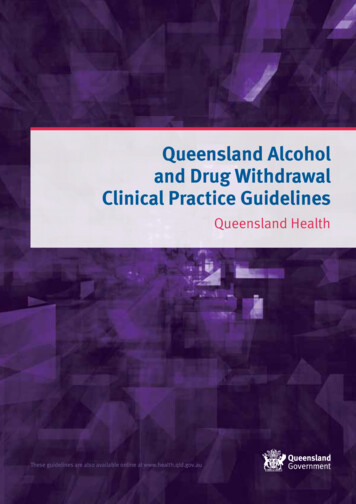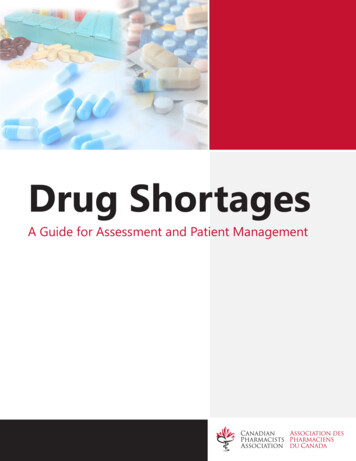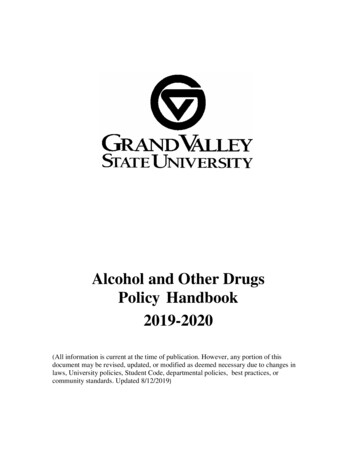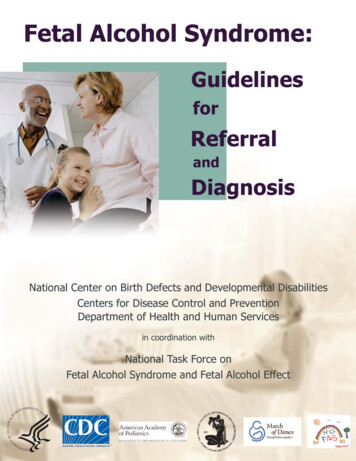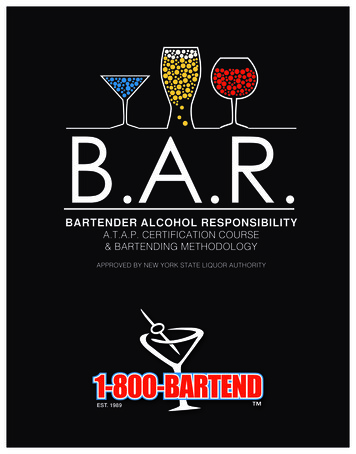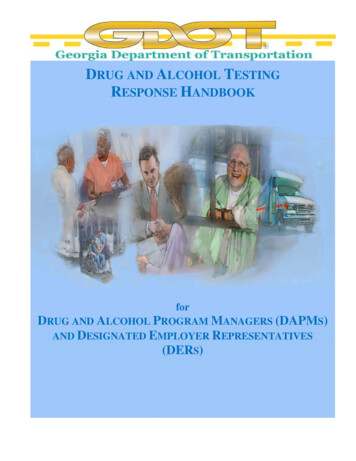
Transcription
DRUG AND ALCOHOL TESTINGRESPONSE HANDBOOKforDRUG AND ALCOHOL PROGRAM MANAGERS (DAPMS)AND DESIGNATED EMPLOYER REPRESENTATIVES(DERS)
What Is The Drug and Alcohol Testing Response Handbook?The Drug and Alcohol Testing Response Handbook is designed to give Drug and AlcoholProgram Managers (DAPM) and Designated Employer Representatives (DER) a quickreference guide to assist in the day-to-day administration of a compliant FTA drug and alcoholtesting program. The information contained in this Handbook is a summary of the informationcontained in 49 CFR Part 40, as amended, and Part 655 and is intended to be a supplement toFTA publications and the technical assistance tools provided on the FTA website(www.fta.dot.gov).Why Was This Handbook Created?We recognize that transit system personnel have many other duties in addition to managing theDrug and Alcohol Testing Program. This Handbook was created to offer the DAPM/DER withan easy reference, action-oriented guide. With the assistance of this Handbook, DAPMs andDERs will be able to efficiently manage their Drug and Alcohol Testing Programs incompliance with U.S. Department of Transportation (U.S. DOT) - FTA regulations.Safety is the number 1 priority at the U.S. DOT. A cornerstone of this safety is ensuring thattransportation providers employ safety-sensitive employees who are 100 percent drug andalcohol free.Over time, the transportation industry has worked hard to reduce the number of accidents andcrashes directly related to drug and alcohol use. Nevertheless, human risk factors remain.MountainLinedespiteTransitserious efforts toSome transportation workers do use illicit drugs or abusealcohol,TransitAuthoritydeter them. We must never stop trying to improve our Mountainsafety recordwheresubstance abuse isOhioValleyRegionalTransitAuthorityconcerned. Employers must have strong drug and alcohol testing programs andmust alsohavePotomactheseValleyTransitthe essential knowledge and tools to implement and managedrugand alcohol testingTri River Transitprograms.Wayne X-PressOur intent is to provide you with the tools and knowledge to accomplish the goal of alwaysimproving the safety of the traveling public.For any questions concerning the drug and alcohol testing program or any informationcontained in this Handbook, please contact: Georgia Department of Transportation, Divisionof Intermodal Programs.Introduction1
AcknowledgementsThis Handbook was originally developed for The West Virginia Department of Transportation,Division of Public Transit.The Following transit systems provided valuable information in the development of thisHandbook:Central West Virginia Transit AuthorityFairmont-Marion County Transit AuthorityHere and There TransitKanawha Valley Regional Transportation AuthorityLittle Kanawha Transit AuthorityMid-Ohio Valley Transit AuthorityMountain Line TransitMountain Transit AuthorityOhio Valley Regional Transportation AuthorityPotomac Valley TransitTriRiver TransitTri-State Transit AuthorityWayne X-PressWe would also like to thank the following people for their review of this manual:Gerald Powers, Federal Transit AdministrationMark Snider, Office of Drug and Alcohol PolicyEve Rutyna and Michael Reddington, Volpe CenterEdited by: Robbie Sarles, Rosamary Amiet, & Sean Oswald, RLS & Associates, Inc.Graphic Artist: Dan MukoIntroduction and AcknowledgementsAcknowledgements22
How To Use This HandbookThis Handbook is designed to assist both new and seasoned Drug and Alcohol Program Managers(DAPMs) and/or Designated Employer Representatives (DERs). Rather than searching throughcumbersome regulatory citations, you can reference this Handbook quickly and easily to access theappropriate guidance.This Handbook is a quick reference guide. Ultimately, you still need to verify the exactregulations as stated within 49 CFR Part 655 and 49 CFR Part 40.Section 1- General Information: General information that will be of use to anyone involved in the Drug and Alcohol TestingProgram.Section 2- Alcohol Testing Procedures: Alcohol testing procedures that are common to all alcohol testing categories (e.g., Random,Post-Accident, etc.). DERs/DAPMs can use this section as a quick reference when contacted by collection sitetechnicians concerning any issues involving a U.S. DOT alcohol test.Section 3- Drug Testing Procedures: Drug testing procedures that are common to all drug testing categories (e.g., Random, PostAccident, etc.). DERs/DAPMs can use this section as a quick reference when contacted by collection sitetechnicians concerning any issues involving a U.S. DOT drug test.Section 4- Contact from the Medical Review Officer (MRO): Procedures and action steps that address specific situations when the Medical Review Officerwould contact the employer. DERs/DAPMs can use this section as a quick reference when contacted by the MedicalReview Officer concerning issues involving U.S. DOT drug test results, verifications, and /orwhen employee contact is required.Section 5- Program Administration: Action steps for administering the Drug and Alcohol Testing Program. DAPMs can use this section as a quick reference on how to properly administer the differentareas of the Drug and Alcohol Testing Program.How to use this handbook3
How to Use This Handbook (continued) In many sections you will seeandsymbols. These thumbs up and thumbs down symbolsindicate areas that require certain actions based on that specific scenario. Each topic provides aclear explanation of the steps and actions required for that scenario. Checklists are included to assistyou in ensuring that all required steps are addressed.In addition to addressing the most common testing categories and other situations a DAPM and/orDER encounters, this manual also covers the less common scenarios. When these rare instancesarise, just locate the appropriate tab and flip to that section for guidance. For example, if you arenotified of an accident involving the operation of a revenue service vehicle, you could grab thishandbook, locate the post-accident tab, and flip to that section for guidance on how to proceed.For your convenience, copies of all the forms related to the Drug and Alcohol Program arelocated at the end of this Handbook.How to use this handbook (continued)3-1
Table of ContentsSECTION 1: GENERAL INFORMATIONIntroductionAcknowledgementsHow to Use This HandbookTable of ContentsGlossary/AcronymsFAQsNew SupervisorsTraining & EducationTestingRecords/ReportingEmployer ResponsibilitiesEmployee ResponsibilitiesApplicant ResponsibilitiesGeneral Testing ProceduresIntroductionNotification of TestingConfidential InformationDelayed Arrival/No-ShowNo Photo IdentificationUncooperative EmployeeTest -6SECTION 2: ALCOHOL TESTING PROCEDURESIntroductionInsufficient BreathTest ResultsLess Than 0.02 0.02, but 0.040.04 and AboveEBT UnavailableFatal FlawsConfirmation TestAir BlankDisplayed Results ErrorCalibration Check ErrorCorrectable FlawsBreath Alcohol Technician Fails to SignNon-DOT Form UsedTest RefusalsCommon Problem AreasTable of Contents1111-111-311-511-611-711-811-94
Table of ContentsSECTION 3: DRUG TESTING PROCEDURESIntroductionInsufficient VolumeTemperature Out of RangeSpecimen TamperingObserved CollectionsCorrectable FlawsNon-DOT Form UsedOther Procedural/Administrative ErrorsTest RefusalsCommon Problem Areas1212-112-312-412-512-712-912-11SECTION 4: CONTACT FROM THE MEDICAL REVIEW OFFICERIntroductionDrug Test ResultsNegativePositiveNegative DilutePositive DiluteExtreme DiluteAdulteratedSubstitutedInvalidSplit SpecimenReconfirmedFailed to ReconfirmCancelled Tests - Fatal FlawsSpecimen I.D. Numbers Do Not MatchSeal is BrokenQuantity Not SufficientCollector Failed to Print & Sign NameEmployee Contact RequiredTable of Contents 3-1013-114-1
Table of ContentsSECTION 5: PROGRAM ADMINISTRATIONSubstance Abuse PolicyIntroductionSubstance Abuse Policy ContentsPre-Employment TestingIntroductionTest ResultsPre-Employment Test Refusals & Insufficient VolumeCommon Problem AreasRandom TestingIntroductionRandom Pool ManagementSchedulingNotificationCommon Problem AreasPost-Accident TestingIntroductionDecision Making StepsProceduresTime RequirementsAccidents Outside of Service AreaCommon Problem AreasReasonable Suspicion TestingIntroductionProceduresTime RequirementsDeterminationConfrontationCommon Problem AreasReturn-to-Duty TestingIntroductionCommunication with the Substance Abuse ProfessionalCommon Problem AreasFollow-Up TestingIntroductionTesting PlanCommon Problem AreasAlcohol Testing FormsAlcohol Testing Form ReviewCompleted Alcohol Testing FormCustody and Control FormsCustody and Control Form ReviewCompleted Custody and Control FormTable of Contents 9-22020-120-22121-12222-24-2
Table of ContentsSECTION 5: PROGRAM ADMINISTRATION (continued)Collection SitesIntroductionOversightAffidavit of CorrectionSubstance Abuse ProfessionalIntroduction / How to Find a SAPCredentialsQualificationsHow to Find a SAPRecord RetentionIntroductionPeriods of RetentionRecent Regulatory 7Appendix: Drug and Alcohol Testing FormsAcknowledgment of Employer’s Drug and Alcohol Testing PolicyAffidavit of CorrectionAuthorization for Release of InformationGood Faith Effort Documentation RecordOrder For TestingPositive Testing LogPost-Accident Testing Decision Report/Decision TreePost-Accident Testing LogPre-Employment Drug Testing AcknowledgementPre-Employment Testing LogRandom Testing LogReasonable Suspicion Incident ChecklistReasonable Suspicion Testing LogReturn-to-Duty/Follow-Up Testing LogSafety-Sensitive Employee Application SupplementSubstance Abuse Professional Referral - Employee Not PresentSubstance Abuse Professional Referral - Employee PresentVendor Oversight Inspection Master LogVendor Oversight Inspection ChecklistTable of Contents (continued)4-3
Glossary/AcronymsATF – Alcohol Testing FormDepartment of Transportation approved form used for alcohol testing.BAT – Breath Alcohol TechnicianIndividual responsible for performing alcohol tests.C/TPA – Consortium/Third Party AdministratorA service agent that provides the provision of a variety of drug and alcohol testing services toemployers.CCF – Custody and Control FormDepartment of Transportation approved form used for drug testing.ContractorAny person or organization that provides a safety-sensitive service for a recipient, subrecipient, oremployer consistent with a specific understanding.DAPM – Drug and Alcohol Program ManagerThe employee responsible for the overall administration of a testing program.DER – Designated Employer RepresentativeThe employee responsible for making decisions and taking immediate action during the testingprocess.DHHS – Department of Health and Human ServicesAgency that certifies drug testing laboratories for participation in U.S. DOT drug testing programs.EBT – Evidential Breath Testing DeviceTesting device used to conduct alcohol tests.FTA – Federal Transit AdministrationThe agency within the U.S. Department of Transportation that provides financial and technicalassistance to public transit systems.MRO – Medical Review OfficerA licensed physician responsible for receiving and reviewing laboratory results and evaluatingmedical explanations for certain test results.ODAPC – Office of Drug and Alcohol Policy and Compliance: Coordinates drug and alcoholtesting program and implementation matters within the U.S. DOT.Glossary / Acronyms5
Glossary/AcronymsQNS – Quantity Not SufficientDonor not able to provide the specified amount of urine during collection.SAP – Substance Abuse ProfessionalA licensed counselor that evaluates employees who have violated a U.S. DOT drug and alcoholregulation.Service AgentAny person or entity who provides services specified under FTA regulations to employers inconnection with U.S. DOT testing requirements.Substance Abuse PolicyThe local governing board of the employer shall adopt a substance abuse policy that is available toeach covered employee.Substance Abuse ProgramEach employer shall establish a substance abuse program consistent with the requirements of 49CFR Part 655.STT – Saliva Test TechnicianIndividual who performs an alcohol test using saliva.THC, COC, PCP, OPI, AMP: On Custody and Control Forms, this series of acronyms representthe type of U.S. DOT drug test that tests for Marijuana (THC), Cocaine (COC), Phencyclidine(PCP), Opiates (OPI), and Amphetamines (AMP).UCT – Urine Collection TechnicianThe collection facility employee responsible for performing drug tests.Glossary / Acronyms (continued)5-1
FAQs-New SupervisorsQ) As the employer, why am I required to perform U.S. DOT testing?A) U.S. DOT testing is required under 49 CFR Part 655, as amended. The regulation requires transitemployers who receive federal funds to establish and conduct a multifaceted anti-drug and alcoholmisuse testing program.Q) Am I required to have a Drug and Alcohol Testing Policy?A) Yes. The aforementioned regulation mandates that each employer have a policy statementdescribing its program policies and procedures. This policy allows employers to communicate totheir workforce what is expected of them and the mandating authority. The policy also allowscovered employees to understand why they are being tested and how the testing should beconducted.Q) Is there a website that provides access to Federal and State Drug and Alcohol TestingRegulations?A) The regulations governing Federal Transit Administration (FTA) Drug and Alcohol TestingPrograms can be found on the FTA website under the Drug & Alcohol page egulations/Regulations/Default.aspx).FAQs - New Supervisors6
FAQs-Training & EducationQ) How do I get training and assistance?A) Training and assistance is available from multiple resources. The Federal Transit Administration(FTA) is a great place to start.Q) What educational information must I provide my employees?A) Before performing safety-sensitive functions, all safety-sensitive employees are required to have60 minutes of training on the effects and consequences of prohibited drug use on personal health,safety, and the work environment, and on the signs and symptoms that may indicate prohibited druguse.All supervisors and/or other company officers authorized by the employer to make reasonablesuspicion determinations shall receive at least 60 minutes of training on the physical, behavioral,and performance indicators of probable drug use and at least 60 minutes of the same training onprobable alcohol misuse.FAQs – Training and Education6-1
FAQs-TestingQ) What type of DOT tests must I conduct?A) Drug and alcohol testing must be conducted in accordance with 49 CFR Part 655, as amended,for pre-employment, random, post-accident, and reasonable suspicion. Under specificcircumstances, return-to-duty and follow-up testing must also be conducted.Q) What is a refusal to test?A) The Federal Transit Administration (FTA) considers any of the following as a refusal to test: Failure to appear for any test (except pre-employment) within a reasonable time as determinedby the employer. Failure to remain at the testing site until testing is complete. Failure to provide a specimen. Failure to permit the direct observation of a test. Failure to follow the observer’s instructions. Failure to provide a sufficient amount of specimen without an adequate medical explanation. Failure to take an additional test as directed. Failure to undergo a medical examination as directed by the Medical Review Officer (MRO). Failure to cooperate with any part of the testing process. Possessing or wearing a prosthetic or other device that could be used to interfere with testing. Admission to the collector or MRO that the specimen was adulterated or substituted. Failure to sign step 2 of the Alcohol Testing Form (ATF).Q) What do I do if an employee tests positive, refuses to test, or has some other violation?A) If an employee tests positive, refuses to test, or violates any area of the Federal TransitAdministration’s (FTA) drug and alcohol testing regulations, you must take immediate action.Upon receiving notification of a positive test, refusal, or violation, you must immediately requirethat the covered employee cease performing a safety-sensitive function. After the coveredemployee has ceased performing safety-sensitive functions, you must ensure that the employee isreferred to a substance abuse professional (SAP) for evaluation and counseling.FAQs - Testing6-2
FAQs-Testing (continued)Q) After referring an employee to an SAP, can I return him/her to the performance of safetysensitive duties?A) You must refer to your local substance abuse policy. Systems that have a zero-tolerance policywill have terminated the employee after referring them to an SAP.Your decision on whether or not to return an employee to duty following apositive test or a test refusal must be based on the procedures outlined withinyour local substance abuse policy. This IS NOT a case-by-case decision. Thedecision must always be consistent with your local substance abuse policy andmust stay consistent with the past practices of your agency.For transit systems that have a zero-tolerance policy, there may be extremely rare circumstanceswhen an employee is reinstated with a court order or other action beyond the control of the transitsystem.If your system has a second-chance policy, you have the decision on whether or not you return theemployee to safety-sensitive duties. This decision must always be consistent with your localsubstance abuse policy and must stay consistent with the past practices within your agency.Only after receiving the follow-up drug and/or alcohol testing plan from the SAP AND a verifiednegative result from a return-to-duty test can you allow the covered employee to return toperforming safety-sensitive duties.Q) What happens if an employee/applicant leaves the testing site before the test is completed?A) On a Pre-Employment test, the applicant consents to the test once the applicant takes thespecimen cup from the collector. If the applicant leaves the testing site prior to receiving thespecimen cup from the collector, this is not considered a test-refusal. If the applicant leaves thetesting site after having received the specimen cup, this is considered a test refusal.For all other testing categories (random, post-accident, return-to-duty, and follow-ups), if theemployee leaves the testing site at any time before the completion of the test, this is considered atest refusal.FAQs – Testing (continued)6-3
FAQs-Records/ReportingQ) Where must I retain drug and alcohol records?A) Under the Federal Transit Administration (FTA), all drug and alcohol testing records must bekept separate from all other employee records. These records must be maintained in a securelocation with controlled access.Q) Is there any required reporting that I must do?A) You must annually prepare and maintain a summary of the results of your anti-drug and alcoholmisuse testing programs performed under 49 CFR Part 655, as amended, during the previouscalendar year (this is known as the MIS Report). You must submit this report annually to FTA’sOffice of Safety and Security.Q) What are the retention requirements for drug and alcohol testing records?Five YearsA. Verified positive drug tests.B. Alcohol test results of 0.02 or greater.C. Documentation of refusals to test.D. Referrals to a Substance Abuse Professional.E. Management Information System (MIS) Reports.F. Evidential Breath Testing device calibration logs.Three YearsInformation obtained from previous U.S. DOTemployers concerning drug and alcohol test resultsof employees.Two YearsA. Records related to the collection process.B. Employee training.C. Post-Accident documentation records.One YearA. Negative drug test documentation.B. Alcohol test documentation for results ofless than 0.02.Best PracticesA. Pre-Employment: The best practice is to maintain all negative Pre-Employment test resultdocuments throughout the period of employment.B. Post-Accident: Regardless of result, the best practice is to maintain all Post-Accident testingdocumentation as long as the statutes of limitations dictate.C. Training: The best practice is to maintain all training records throughout the period of employment.D. Oversight of Collection Site(s): The best practice is to maintain this documentation indefinitely.E. Previous U.S. DOT Employer Record Checks: The best practice is to keep these recordsthroughout the period of employment.F. Positive Test Result Documentation: The best practice is to maintain these records indefinitely.FAQs – Records/Reporting6-4
Employer Responsibilities Employers are responsible for meeting all requirements and procedures of 49 CFR Part 655 and 40,as amended. The Drug and Alcohol Manager (DAPM) is the primary individual designated by theemployer to be responsible for the overall administration of the program.Each employer must have a current, board-approved, Substance Abuse Policy establishing allrequirements of the substance abuse program. The Substance Abuse Program must meet allrequirements stated within the policy. While the employer must update this policy as requiredwhen regulatory updates and/or changes are published by the Federal Transit Administration(FTA), the best practice is to review and update your Substance Abuse Policy annually.Service agents are required to carry out the requirements of the U.S. DOT agency regulations. Aprocess must be in place to provide oversight of service agents.Employers are responsible for providing 60 minutes of training to all safety-sensitive employees onthe effects and consequences of prohibited drug use. Furthermore, 120 additional minutes oftraining on the performance indicators of drug use and alcohol misuse must be provided to allsupervisors authorized by the employer to make reasonable suspicion determinations.As the employer, you are responsible for obtaining information from your service agents;for example, Test Results, Substance Abuse Professional’s Report, Laboratory Statistical Reports,and Service Agent’s Credentials.Employer Responsibilities7
Employer Responsibilities (continued)As the employer, you must provide the following information to the collector when conducting aurine specimen collection or breath alcohol test: Full name of the employee being tested. Employee SSN or ID number. Laboratory name and address. Employer name, address, phone number, and fax number. DER name and telephone number. MRO name, address, phone number, and fax number. The U.S. DOT agency which regulates the employee’s safety-sensitive duties (e.g., FTA). The reason for the test, as appropriate: Pre-employment; Random; Reasonable Suspicion;Post-Accident; Return-to-Duty; and Follow-up. Whether or not the test is to be observed.This information is provided on the Order for Testing Form.As the employer, you must request the following information about an employee who has beenemployed by a U.S. DOT-regulated employer during any period within the previous two years: Obtain the prospective safety-sensitive employee’s written consent for release ofinformation. Alcohol tests with a result of 0.04 or higher alcohol concentration. Verified positive drug tests. Refusals to be tested (including verified adulterated or substituted drug test results). Other violations of a U.S. DOT agency drug and alcohol testing regulations. If the employee has previously violated a U.S. DOT drug and alcohol regulation, you mustobtain documentation of the employee’s successful completion of a U.S. DOT return-to-dutyprocess. You must maintain a confidential written record of the information you obtain or of thegood faith efforts you made to obtain the information. You must ask the employee whether he or she has tested positive or refused to test onany pre-employment drug or alcohol test for an employer to which the employee appliedfor, but did not obtain safety-sensitive work during the previous two years.This information is provided on the Safety-Sensitive Employee Application SupplementForm.See sample forms on the following pages.Employer Responsibilities (continued)7-1
Employer ResponsibilitiesTo be completed by collection site personnel uponarrival at site and returned to emp loyer withEmployer’s copy of Chain of Custody Form.ORDER FOR TESTINGTimeDateCollection SitePersonnel In itialsThe Federal Transit Administration issued regulations (49 CFR Part 655)that require all safety-sensitive employees/applicants to submit to drugPrint Collection Site Pers onnel Nameand alcohol testing as a condition of employment in a safety-sensitiveposition. Refusing to submit to testing; providing false information inconnection with said testing; adulterating, substituting, or tampering with the specimen; or failing tocooperate with any part of the collection process is a violation of the regulations and of company policy.Testing is to be accomplished on the date, time and location indicated below. You must present thisform at the collection site.Print Full Name: ID #Collection Site Location:You must report no later than am/pm, on (date)Failure to complete a drug and/or alcohol test will be considered a test refusal.* Pre-emp loyment tests New applicants, transfer from a non-safety-sensitive position, return to active status.** Return-to-Duty tests Only performed following a positive/refusal to test and successful completion of SAPcoun seling.Type of Test:DrugAlcoholBothTest Authority:DOT-FTANon-DOTDOT- OtherTest ble SuspicionReturn-to-duty**Follow-upRetest, Specify:Observed Collection:YesNoTransported:Yes, By Whom:Picture ID:YesNoNoOther Special Instructions:Supervisor Authorizing Test:P rint NameDateTime NotifiedDesignated Employer Representative / DAPM:Print NameEmployer Responsibilities (continued)Phone Number7-2
Employer ResponsibilitiesSAFETY-SENSITIVE EMPLOYEE APPLICATIONSUPPLEMENTPrevious US Department of Transportation Drug and Alcohol TestingI,Print First Name, Middle Initial, Last Name,Social Security NumberAttest that:I have participated in DOT-regulated drug and alcohol testing with previous employers.1. Have you tested positive (0.04 or greater) for alcohol in the last two years?YesNo2. Have you had a verified positive drug test result in the last two years?YesNo3. Have you refused a required drug or alcohol test in the last two years (or had a verified adulterated orsubstituted drug test result)?YesNo4. Have you tested positive, or refused to test, on any pre-employment drug or alcohol test administeredby an employer to which you applied for, but did not obtain, safety-sensitive transportation workcovered by DOT agency drug and alcohol testing rules in the last two years?YesNo5. Have you violated any other DOT drug or alcohol testing regulation within the last two years?YesNoIf you responded “YES” to any of the above questions, please provide documentation or your successfulcompletion of DOT return-to-duty requirements. If you do not have this information, please explainwhy:(Use additional pages as necessary)“I certify that the facts contained in this form are true and complete to the best of my knowledge andunderstand that, if employed, falsified statements on this form shall be grounds for dismissal.”SignedEmployer Responsibilities (continued)Date7-3
Employee ResponsibilitiesAn employee must be determined to have refused a test if any of the following circumstanceshave occurred: Failure to appear for any test (except pre-employment) within a reasonable time as determinedby the employer. Failure to remain at the testing site until testing is complete. Failure to provide a specimen. Failure to permit the direct observation of a test. Failure to follow the observer’s instructions. Failure to provide a sufficient amount of specimen without an adequate medical explanation. Failure to take an additional test as directed. Failure to undergo a medical examination as directed by the Medical Review Officer (MRO). Failure to cooperate with any part of the testing process. Possessing or wearing a prosthetic or other device that could be used to interfere with testing. Admission to the collector or MRO that the specimen was adulterated or substituted. Failure to sign step 2 of the Alcohol Testing Form (ATF).If an employee has previously been employed by a U.S. DOT agency within the last two years,he or she cannot perform safety-sensitive functions until consent for the release of their U.S. DOTDrug and Alcohol testing records from previous U.S. DOT employers has been given. This includesa current non-safety-sensitive employee that is being transferred into a safety-sensitive position.Employee Responsibilities8
Applicant ResponsibilitiesIf an applicant does not show up to a scheduled U.S. DOT Pre-Employment drug test, theapplicant shall not be considered to have refused the test.An applicant can only be considered to have refused a U.S. DOT Pre-Employment drug test if theapplicant has committed to the testing process (i.e., accepted the collection cup), and thenrefuses to complete the test.If an applicant is not able to provide a sufficient amount of urine during the testing process andHAS received a conditional offer of employment, the applicant must undergo a medicalexamination from a licensed physician within 5 days to determine if there is a medical explanationfor the inability to provide a specimen. If the applicant does not receive a medical examinationwithin 5 days (the MRO can allow longer, if appropriate), the applicant should be considered tohave re
The Drug and Alcohol Testing Response Handbook is designed to give Drug and Alcohol Program Managers (DAPM) and Designated Employer Representatives (DER) a quick reference guide to assist in the day-to-day administration of a compliant FTA drug and alcohol testing program. The information contained in this


